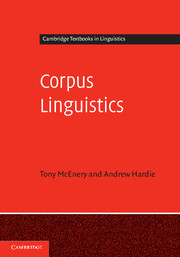Book contents
- Frontmatter
- Contents
- List of figures
- List of tables
- Acknowledgements
- Preface
- 1 What is corpus linguistics?
- 2 Accessing and analysing corpus data
- 3 The web, laws and ethics
- 4 English Corpus Linguistics
- 5 Corpus-based studies of synchronic and diachronic variation
- 6 Neo-Firthian corpus linguistics
- 7 Corpus methods and functionalist linguistics
- 8 The convergence of corpus linguistics, psycholinguistics and functionalist linguistics
- 9 Conclusion
- Glossary
- Notes
- References
- Index
5 - Corpus-based studies of synchronic and diachronic variation
Published online by Cambridge University Press: 05 June 2012
- Frontmatter
- Contents
- List of figures
- List of tables
- Acknowledgements
- Preface
- 1 What is corpus linguistics?
- 2 Accessing and analysing corpus data
- 3 The web, laws and ethics
- 4 English Corpus Linguistics
- 5 Corpus-based studies of synchronic and diachronic variation
- 6 Neo-Firthian corpus linguistics
- 7 Corpus methods and functionalist linguistics
- 8 The convergence of corpus linguistics, psycholinguistics and functionalist linguistics
- 9 Conclusion
- Glossary
- Notes
- References
- Index
Summary
Introduction
In this chapter, we turn our attention to the issue of linguistic variation, and how corpora have been employed to study differences in the English language across time and across different contexts of language use. We can interpret variation in a number of different ways. One is change over time or diachronic variation. In the two sections that follow, we will look at the use of corpora to study language change in pre-contemporary and contemporary English, respectively. Yet while corpus-based analysis of language change is a broad field, the study of synchronic variation is even more extensive. In exploring corpus-based approaches to synchronic variation, we will focus on two rather distinct approaches. One approach, touched on briefly in the previous chapter, is strongly associated with Douglas Biber and colleagues; this is the so-called multi-dimensional (MD) approach. The other is associated with variationist socio-linguistics. Although, as we will see, these approaches have certain commonalities, they are distinct in that the MD approach looks at variation across genre (or register), with the individual text as the unit of variation, whereas variationist sociolinguistics looks at variation across class, gender or other social category, with the individual speaker as the unit of variation. We will discuss the MD approach, in particular, at some length, because it is methodologically extremely distinct and statistically sophisticated.
Diachronic change from Old English to Modern English
Looking at language change is an area of linguistics for which corpus data is particularly appropriate. No one now alive speaks Middle English as a native tongue, much less Old English; thus, even if we wish to rely on the judgements of a native speaker, we simply cannot. Instead, for these and other extinct languages there is a fixed ‘corpus’ of surviving texts which will never grow any further, except in the rare circumstance that hitherto unknown texts are discovered. An electronic corpus composed of all of these surviving texts (or a sampled subset of them) is thus the ideal tool for taking into account as much data on these historical forms as possible in an analysis of how language has changed. The quantitative analyses enabled by corpus methods are also highly valuable for the study of language change. One quite consistent finding of research in historical linguistics is that one structure very rarely replaces another in a single, sudden change. Rather, new structures arise and are initially used infrequently, and then may later increase in frequency of use, perhaps in competition with some established structure (some examples are discussed in the following section). This kind of quantitative pattern is ideally tracked by a corpus sampling texts across time.
- Type
- Chapter
- Information
- Corpus LinguisticsMethod, Theory and Practice, pp. 94 - 121Publisher: Cambridge University PressPrint publication year: 2011
- 1
- Cited by



